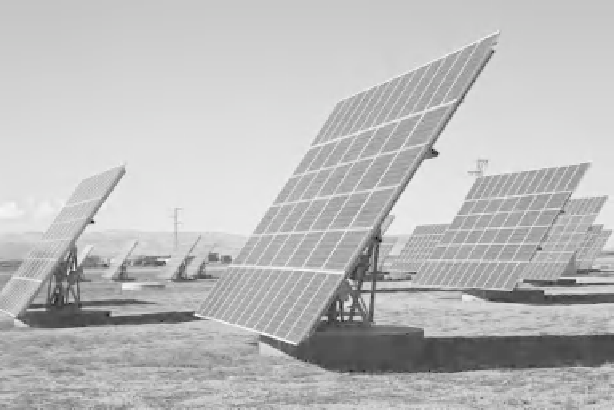Environmental Engineering Reference
In-Depth Information
Picture 6.1
Self-tracking photovoltaic panels used to maximize transformation of solar energy into electricity.
Courtesy of U.S. Department of Energy.
TECHNOLOGY CYCLES
Innovation can be classified into two broad categories: incremental and breakthrough.
Incremental innovation consists of making small consecutive improvements to the current
technology platforms. A breakthrough innovation, on the other hand, sometimes called radical
innovation, is a complete change in the technology that cannot be compared with the existing
one (Leifer et al., 2000). Initiatives for incremental innovation may come from research and
development (R&D) or as a response to market demands, whereas breakthrough innovations
are strictly a product of R&D.
Technologies go through cycles like everything else. All technology cycles are preceded by
some type of breakthrough innovation, which in most cases is not clearly identifiable when it
takes place. Only after time passes, can these breakthroughs be identified in retrospect.
Adoption of new technologies follows an S-shaped growth curve similar to ones for
introduction of new products. This curve represents the cumulative market share as a function
of time (Cosier and Hughes, 2001) (Fig. 6.1). The introduction period is sluggish in terms of
market share and is characterized by lack of competitiveness with existing technologies in
terms of performance and price. Once the technology proves to be good enough to stay, the
S-shaped curve starts bending upward and goes through a period of superior performance, but
it is still not competitive in economic terms. If the price hurdle is finally overcome, then the
curve goes through a linear growth period up to the point where it starts bending downward
and levels off as an indication of market saturation. If no new competing alternatives are intro-
duced in the market at this point, the new technology (not so new anymore) can become what
in business is called a “cash cow.” Or if new competitive alternatives are introduced, then the
technology falls into obsolescence.
In terms of proportion of adopters as a function of time, the adoption of new technologies
can be represented by a frequency-distribution bell-shaped curve called the technology
adoption life cycle (Fig. 6.2). According to this model, new technology adopters are divided
into five different categories (Rogers, 2003; Ryans, 1999):





